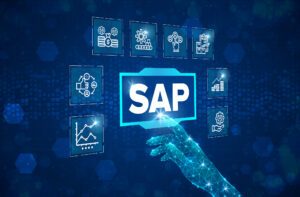Home » What is a SAP Intelligent Enterprise?
What is a SAP Intelligent Enterprise?
By vVolve
What is a SAP Intelligent Enterprise?
At SAPPHIRE NOW this year, SAP shared their vision of businesses of the future could operate the Intelligent Enterprise. It is a truly revolutionary, yet fully realistic idea that can transform an enterprise operationally to the leading edge. I personally was at SAPPHIRE NOW to find out more about what is on offer and how best to translate vision to reality for our clients.
While inspiring, the SAP Intelligent Enterprise is a big all-encompassing concept that needs to be broken down to understand. What does it mean to be an Intelligent Enterprise? Why do enterprises need to become intelligent? How can enterprises become intelligent? What is the roadmap to intelligence?
In this article, I answer the first question: What does it mean to be an Intelligent Enterprise?
Effective use of data assets
SAP Intelligent Enterprises are those that effectively use their data assets to achieve their desired outcomes faster and with less risk. In other words, an enterprise that efficiently captures useful data from their business processes, effectively uses that data to inform decision making, and hosts their data in a secure and connected platform. An SAP Intelligent Enterprise is also one that interacts intuitively with users, like an intelligent being.
Business processes powered by SAP Intelligent Suite
SAP’s Intelligent Suite provides integration-ready applications to help run business processes in a digitized, consistent and intuitive manner. The applications include Digital Core (SAP S/4 HANA, Cloud ERP), Manufacturing and Supply Chain (including IoT), Customer Experience (CRM), People Engagement (SuccessFactors, HCM) and Network and Spend Management (Ariba, Fieldglass, Concur).
While these applications are familiar to most of us, the interface has changed. SAP Fiori UX has made these intuitive, mobile and easy to use. Robot Process Automation (RPA) can now automate repetitive tasks, increasing efficiency and minimizing human errors. SAP CoPilot is a context aware digital assistant that helps the user complete transactions through conversations, while SAP Conversational AI provides an end-to-end toolkit for training, building and monitoring chatbots that can be integrated with both SAP and non-SAP systems.
Analytics and decision-making powered by SAP Leonardo and Intelligent Technologies
The power of data lies in the ability to analyse it and draw insights for decision-making. SAP Leonardo and its Intelligent Technologies, therefore, is the heart of the Intelligent Enterprise. SAP has incorporated innovative technologies like Machine Learning, Blockchain, Internet of Things, Analytics, Big Data and Data Intelligence to deliver cutting edge analytics that not only describe, but can predict and prescribe. The design thinking methodology and innovation toolkits in SAP Leonardo will help you identify and develop the right use cases for your enterprise. This is the game changer that, I believe, when implemented well, can help enterprises to make the leap into the leading edge.
Trusted, unified, in-memory, cloud based data platform
One can imagine that it must be a daunting task to effectively manage the massive amounts of data needed by an Intelligent Enterprise, and at the same time, ensure its security. SAP’s answer to this challenge is the SAP HANA Data Management Suite, which collects and integrates data from multiple sources into a unified landscape. At the same time, its data management framework and in-memory database allows you to take full advantage of the Intelligent Technologies while reducing the complexity of delivery.
To further minimize IT infrastructure complexity, SAP Cloud Platform provides off-premise open platform-as-a-service that allows enterprises to quickly and easily build and extend the intelligent, mobile-enabled cloud applications that you need.
It may seem, by now, that it takes an entire overhaul of internal systems and a total external facelift to become an Intelligent Enterprise, which will require significant time and monetary investments, as well as major change management efforts. Why is it worth doing this? And how do I make the transition while minimizing risks to my organization? I will try to answer these two questions in subsequent articles.
ARCHIVES
- March 2024 (1)
- January 2024 (1)
- October 2023 (4)
- September 2023 (1)
- June 2023 (3)
- May 2023 (5)
- April 2023 (1)
- August 2021 (1)
- July 2021 (1)
- October 2020 (3)
- February 2020 (1)
- December 2019 (1)
- December 2018 (1)
- October 2018 (1)
- September 2018 (1)
- August 2018 (2)
- July 2018 (2)
- March 2018 (1)
- April 2017 (1)
- October 2016 (1)
- September 2016 (2)
- August 2016 (2)
- July 2016 (2)
- June 2016 (1)
- May 2016 (2)
- April 2016 (2)
- March 2016 (2)
Latest Articles
Harness the Power of Cloud ERP
Companies that are taking advantage of the cloud are the ones leading in their field. Their strategic actions often give them a competitive advantage and help them market share by improving customer experiences.
How vVolve & SAP EWM Can Help Your Warehouse Reach Its Full Potential?
Discover how vVolve with SAP EWM can help address challenges in Warehouse Operations which is an important area in supply chain and which requires extensive cross functional cooperation between purchasing, manufacturing, sales, transportation, workforce management departments.
Discover how Application Management Solutions (AMS) can enhance SAP performance and reliability. Explore proactive monitoring, scalability, cost efficiency, improved security, regular updates, enhanced user experience, and business continuity.
SAP HANA On-Premise Migration: Best Practices and Considerations
Explore the best practices and essential considerations for a seamless SAP HANA on-premise to cloud migration. Learn how to assess your current environment, define clear objectives, plan infrastructure, backup data and ensure version compatibility.





